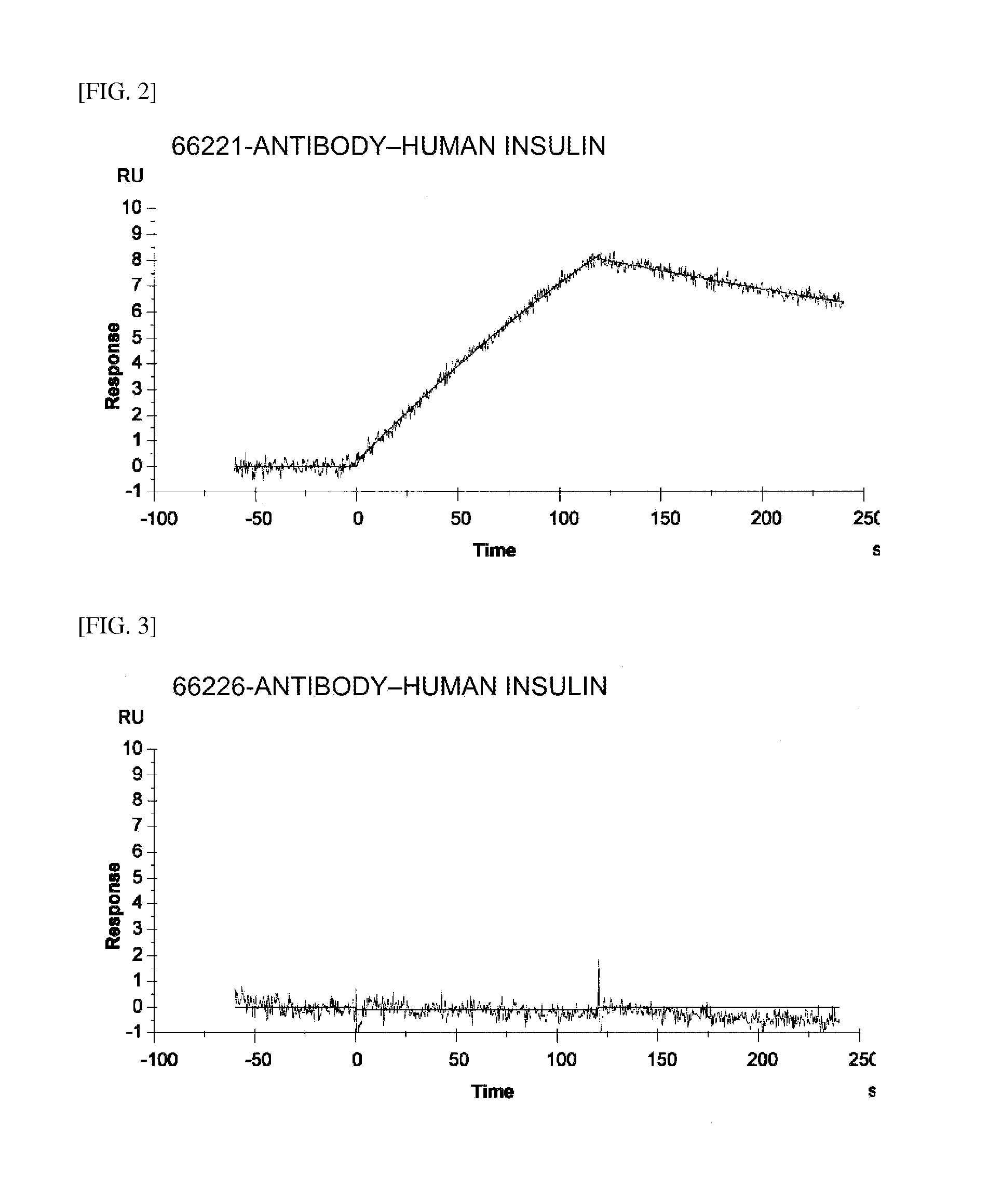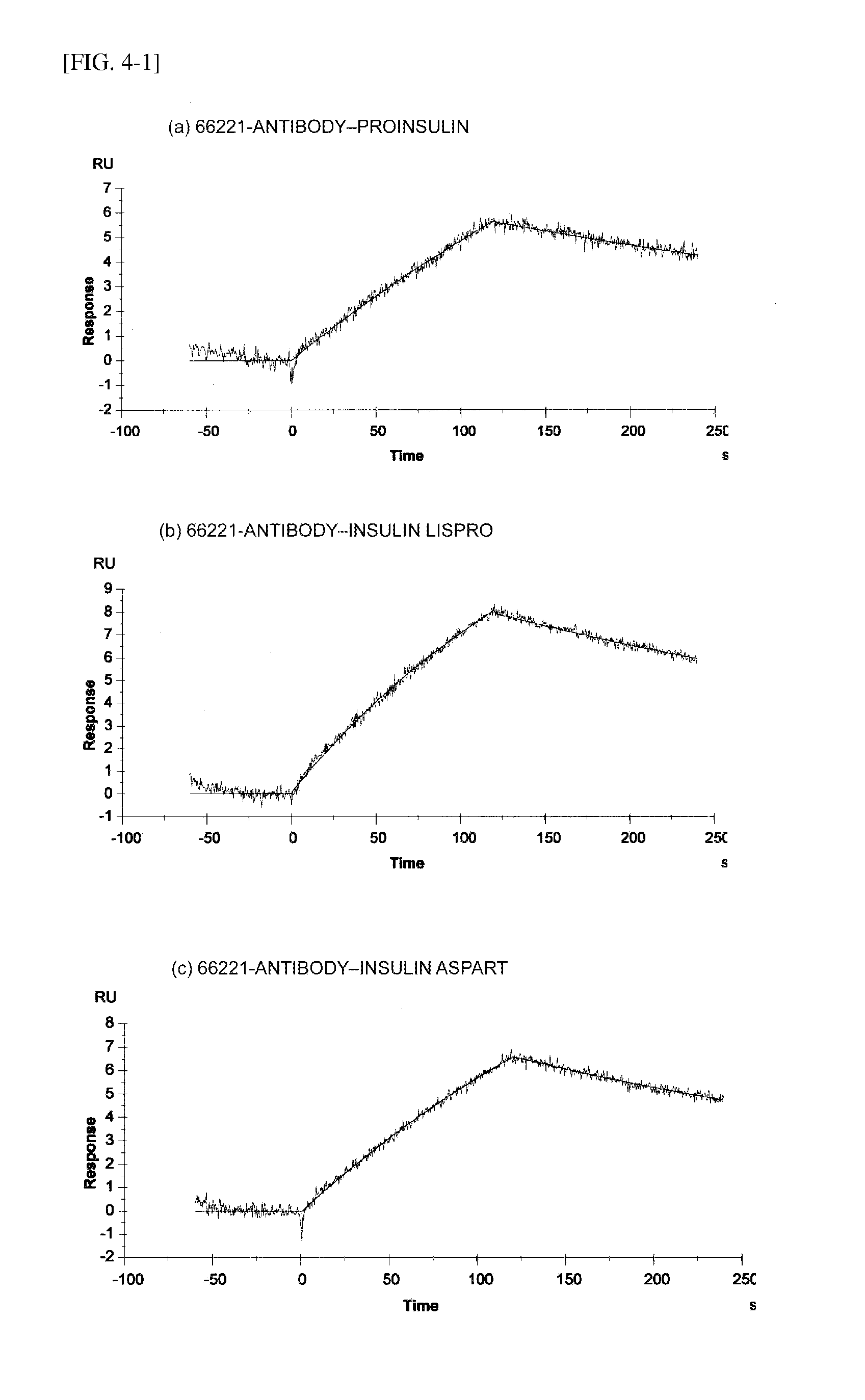Insulin assay
a technology for assaying insulin and assay reagents, which is applied in the field of assaying insulin and assaying insulin assay reagents, can solve the problems of not knowing whether insulin can be measured specifically and sensitively, and achieve the effect of sensitive and specific assaying and accurate monitoring
- Summary
- Abstract
- Description
- Claims
- Application Information
AI Technical Summary
Benefits of technology
Problems solved by technology
Method used
Image
Examples
example 1
Assay of Insulin Using Combination of Monoclonal Antibodies of the Present Invention 1
[0175]1. Production of Latex Particles
[0176]A glass reaction container (capacity: 2 L) equipped with a stirring machine, reflux condenser, thermal sensing device, nitrogen introduction tube, and jacket was filled with 1100 g of distilled water, 200 g of styrene, 0.2 g of sodium styrene sulfonate, and aqueous solution of 1.5 g of potassium peroxodisulfate dissolved in 50 g of distilled water, and after the inside of the container was replaced with nitrogen gas, polymerization was performed for 48 hours while stirring at 70° C.
[0177]After the end of polymerization, the solution was filtrated with a filter paper to extract latex particles. A transmission electron microscope apparatus (JEOL Ltd., model “JEM-1010”) was used for imaging the latex particles at a magnification of 10000 times and analyzing diameters of at least 100 acquired latex particles to determine the average particle diameter. The obt...
example 2
Assay of Insulin Using Combination of Monoclonal Antibodies of the Present Invention 2
[0192]Either the 66221-antibody or 66226-antibody was solid-phased, and the rest was used as a secondary antibody to test the reactivity with proinsulin and insulin analogs by ELISA.
[0193]1. Antibodies and Antigens Used
[0194](1) Monoclonal Antibodies
[0195]66221-antibody: 2.30 mg / mL
[0196]66226-antibody: 3.99 mg / mL
[0197](2) Antigens
[0198]Insulin, proinsulin, and insulin analog formulations (insulin lispro, insulin aspart, insulin glargine, and insulin detemir) used were the same as the second test example.
[0199]2. ELISA method
[0200](i) The solution of the 66221-antibody or 66226-antibody diluted to 2 μg / mL with PBS was solid-phased in a 96-well plate at 50 μU / well and allowed to stand two hours at room temperature.
[0201](ii) After washing three times with 400 μU / well of PBST, BSA-PBST was dispensed at 100 μL / well and allowed to stand one hour at room temperature for blocking in order to produce an EL...
example 3
Assay of Insulin Using a Combination of Monoclonal Antibodies of the Present Invention 3
[0231]Either the 66221-antibody or 66226-antibody was solid-phased, while the other antibody was combined as a secondary antibody to test the reactivity with insulin, proinsulin, and an insulin analog by ELISA.
[0232]1. Antibodies and Antigen Types Used
[0233](1) Monoclonal Antibodies
[0234]66221-antibody: 2.30 mg / mL
[0235]66226-antibody: 3.99 mg / mL
[0236](2) Antigens: insulin, proinsulin, and an insulin analog formulation (insulin glulisine)
[0237]2. ELISA Method
[0238]The same method as in Example 2 is performed, except that insulin glulisine was used as the insulin analog formulation.
[0239]3. Result
[0240]3-1. 66221 Solid-Phase Antibody Plate Assay Results
[0241]Test results are depicted in Table 4 and FIG. 9.
[0242]As was the case with Example 2, when the 66221-antibody was used as the primary antibody and the 66226-antibody was used as the secondary antibody, a concentration-dependent increase in abso...
PUM
| Property | Measurement | Unit |
|---|---|---|
| particle diameter | aaaaa | aaaaa |
| particle diameter | aaaaa | aaaaa |
| concentration | aaaaa | aaaaa |
Abstract
Description
Claims
Application Information
 Login to View More
Login to View More - R&D
- Intellectual Property
- Life Sciences
- Materials
- Tech Scout
- Unparalleled Data Quality
- Higher Quality Content
- 60% Fewer Hallucinations
Browse by: Latest US Patents, China's latest patents, Technical Efficacy Thesaurus, Application Domain, Technology Topic, Popular Technical Reports.
© 2025 PatSnap. All rights reserved.Legal|Privacy policy|Modern Slavery Act Transparency Statement|Sitemap|About US| Contact US: help@patsnap.com



